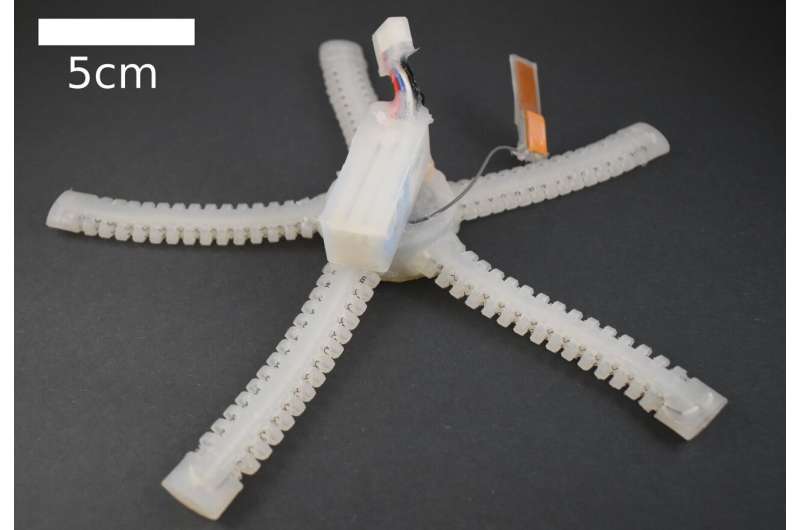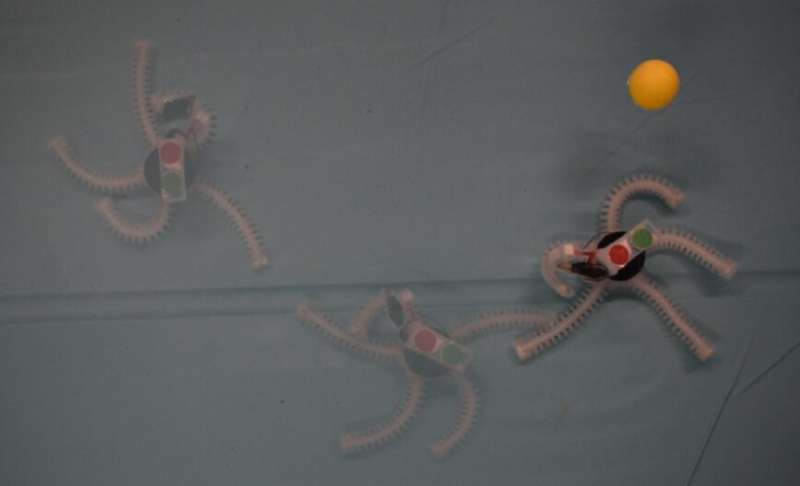April 21, 2020 feature
This is PATRICK: Meet the brittle star-inspired robot that can crawl underwater

Researchers at Carnegie Mellon University have recently created PATRICK, an untethered soft robot that artificially replicates the structure and behavior of the brittle star, a marine invertebrate closely related to starfish. This unique bio-inspired robot, presented in a paper pre-published on arXiv, can crawl underwater using five legs actuated by shape-memory alloy (SMA) wires.
"This work came about as a natural extension of our lab's previous work in creating untethered soft robots using muscle wire in place of electrical motors," Zach Patterson, one of the researchers who carried out the study, told TechXplore. "Our inspiration for PATRICK comes from the brittle star, a surprisingly agile relative of the sea star."
Patterson and his colleagues set out to develop a soft robot that could complete simple missions underwater, but that could also enhance the current understanding of the brittle star and its underwater crawling behavior. To reproduce the brittle star's ability to walk underwater most effectively, the researchers felt that their robot should not be tethered to external hardware, as this would allow it to move around more freely.
PATRICK, the robot they developed, has five limbs powered by coils of SMA. SMA is a type of metal with a number of advantageous properties, including a high flexibility at room temperature and a unique behavior when heated. When an electric current is applied to it, in fact, SMA metal rapidly heats up and returns to a shape that it acquired in the past.
"We use these shape-changing coils as a kind of 'muscle," causing the robot's legs to bend in desired directions," Patterson said. "The robot is mostly made of silicone, making it highly flexible and waterproof. In order to control PATRICK's motion, we developed several motion primitives: specific patterns of shape change coordinated among the limbs that move the robot as a whole."
In addition its high flexibility, Patterson and his colleagues wanted their robot to be able to sense its surrounding environment and choose what direction to move in autonomously. To achieve this, they developed a framework that allows the robot to communicate with devices outside of the water while it is submerged, via wireless communication. This gives PATRICK additional capabilities that do not solely rely on the relatively inexpensive hardware components that make up its body, allowing it to autonomously sense its environment and carry out computations.

Another interesting property of the soft robot developed by Patterson and his colleagues is that it can perform a wide variety of possible motions underwater, as its legs are made of several SMA 'muscles' that can rearrange in different ways. This is somewhat rare for mobile soft robots, which are typically only capable of a few simple movements or locomotion styles.
"We demonstrated that the robot can move to desired goals in real-time, a first among untethered soft robots," Patterson said. "In addition, we found that a soft robot that is not tethered to any external hardware can reach a moving target on its own, even when there is large degree of uncertainty in its surrounding environment and in the behavior of the robot itself. In fact, due to the complex interactions between temperature, material deformation and things like friction, we are never quite sure about how the robot will move in response to a given command."
PATRICK's ability to move autonomously underwater is a direct result of its flexible and complex structure. Although its intricate design also makes its behavior difficult to predict, it ultimately allows the robot to automatically react to disturbances in its environment by deforming and changing shape, without the need for expensive and highly performing control algorithms.
In the future, the brittle-star-inspired robot developed by this team of researchers could have numerous useful applications. For instance, it could be used to carry out geological explorations and achieve minimally invasive ecological or biological sampling. In addition, Patterson and his colleagues hope that PATRICK will also aid the study of the mechanisms behind brittle star locomotion.
"In our next studies, we will experiment with more control and planning algorithms, develop machine learning approaches for control, and implement sensors in the structure to allow the robot to tackle a wider variety of useful tasks," Patterson said. "As mentioned in our initial objectives, we also plan to use PATRICK to better understand brittle star locomotion and underwater walking in general."
More information: An untethered brittle star robot for closed-loop underwater locomotion. arXiv:2003.13529 [cs.RO]. arxiv.org/abs/2003.13529
Xiaonan Huang et al. Highly Dynamic Shape Memory Alloy Actuator for Fast Moving Soft Robots, Advanced Materials Technologies (2019). DOI: 10.1002/admt.201800540
Xiaonan Huang et al. Chasing biomimetic locomotion speeds: Creating untethered soft robots with shape memory alloy actuators, Science Robotics (2018). DOI: 10.1126/scirobotics.aau7557
© 2020 Science X Network




















